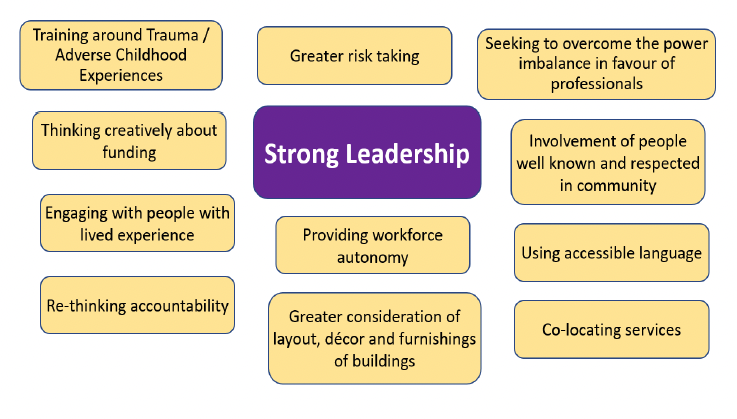Covid recovery: learning from person-centred approaches
This report draws on four case studies of person-centred approaches to public service delivery, along with wider evidence, and summarises learning from person-centred approaches
4. What factors enable public services to adopt a stronger Person-centred approach?
Although the above barriers represent multiple potential challenges, the case studies and evaluations highlighted in this paper provide examples of how different types of barriers might be overcome in order to develop and strengthen person-centred approaches.
However, some of the challenges to person-centred approaches described within the previous section are deeply entrenched and will be harder to overcome and may require legislative change. [36]
In order to realise person-centred approaches, strong leadership is required across policy design and delivery. The figure below highlights some of the key ways through which barriers to person-centred approaches can be overcome.

Potential Solutions to Administrative Barriers
It is important for agencies to work more collaboratively with one another. The Pathfinder process evaluation identifies the benefits of services being co-located, encouraging a move away from a competitive environment towards a more cooperative one. [19] Promoting flexible person-centred approaches provides an opportunity for agencies to identify gaps in local service provision and to find creative ways of meeting complex needs, continuing the positive work undertaken during the pandemic, as described in the review of innovation and creativity in the third sector in response to COVID-19. [31] Drawing on strengths within informal networks and communities, may reduce demands on public services.
Limited funding raises a significant challenge to providing bespoke, holistic, and continued long term involvement from services. A move away from precarious short-term to more stable longer term funding is necessary.
Recognising active engagement as a significant achievement, as in the process evaluation of the Dundee and Glasgow Pathfinders, is important in measuring progress [19] Conversely, where the lack of an exit strategy is problematic, knowledge of other, more appropriate, services may facilitate a smooth transfer for the person. Additionally, a strength-based approach will assist in identifying a point where the person no longer requires the service. The strong relational aspect of person-centred approaches may make endings more difficult, and The Promise suggests that the workforce may need to be afforded permission to maintain contact once a person or family has moved on, if appropriate.[1]
Tackling Cultural Barriers
Some barriers exist within the workplace andthe community, and it is important that the attitudes, anxieties, and concerns which may underpin these are identified and addressed.
Public awareness and community engagement may facilitate a positive change in perceptions of stigmatised and marginalised people. For example, where people know someone with a substance use issue, they are more likely to hold less punitive views.[16] Further, people with lived experience may engage effectively in raising awareness and promoting inclusivity through relating their strength-based experiences of recovery and hope.
Additionally, workforce training is acknowledged as necessary in promoting holistic practices. In particular training around trauma and the effect of Adverse Childhood Experiences is advocated across various service areas, such as stated in The Promise [1], Changing Lives [16], and the Expert Review of Mental Health Services in HMYOI Polmont [17]. Further, The Promise recognises that the workforce require to be supported in their own experiences of working with trauma. [1]
In order to move away from overly risk averse practices, policy should prescribe assessment tools and interventions which support this. As described by the Dundee Fairness Commission [37], individuals hold a complex range of values, some in conflict, often requiring a trade-off between risks and needs. The Promise argues that it is necessary for the workforce to have an understanding of the importance of positive risk taking. [1] A supportive organisational culture that supports and enables this approach (dedicating time, reflective practice to support staff etc.) - and supervision is central to this shift.
In order to overcome the imbalance of power in favour of professionals, some behavioural changes are required. The Promise [1] advocates the use of everyday language and the absence of professional identifiers such as lanyards, which may narrow the gap between workforce and families. Similarly, the House of Care evaluation [34] reported how practices, such as providing test results in advance of appointments to people using health care services, create a more equal partnership. Workforce respondents reported positive experiences around this shift in dynamic, leading to greater job satisfaction; this could be used at training events to engage professionals with the benefits of partnership working and co-production.
Where there may be feelings of mistrust towards organisations, the use of people who are well known and respected within groups to make contact can be effective. This was found across settings such as in the Pathfinders process evaluation [19], at HMYOI Polmont [17] and within migrant communities [22]. Further, active outreach, drop-in sessions and telephone contact enabled people to choose a way of engaging which suited them and promoted trust.
Tackling Barriers presented by the Built Environment
The Promise [1], the Pathfinder process evaluation [19], and the Expert Review of Mental Health Services at HMYOI Polmont [17] all relate the influence of the built environment on how services are received. New or refurbished premises should take into account trauma-informed practices. Where services are working in existing facilities, people using the facility should be consulted, to understand the impact of the physical surroundings on experiences of accessing and receiving support. Consideration should be given to the messages communicated to people by the environment, its layout, décor, and furnishings. Care should also be taken around how the built environment supports ethical principles such as privacy and confidentiality.
Contact
Email: socialresearch@gov.scot
There is a problem
Thanks for your feedback